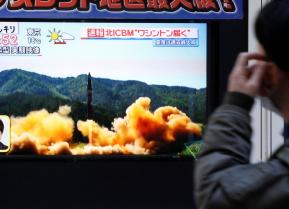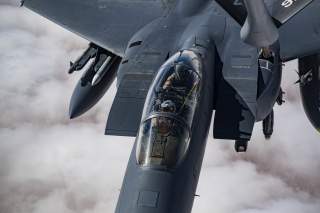How the United States Would Attack North Korea
Welcome to World War III.
No other country can match the United States when it comes to projection of power. Should Washington decide to carry out a military strike against North Korea, even a limited one, the immediate impact would be devastating for Pyongyang. When considering military action, however, it is important to acknowledge the variables and intelligence gaps that inevitably complicate political and military decision-making. Even with the United States' advantage in training, coordination and equipment, complicating factors and uncertainty about the exact locations and dispositions of North Korean assets make complete mission success far from assured.
It is important to consider the parameters of any operation; in this case, we are basing our assumptions on a scenario in which the United States conducts a limited, stealthy attack using a small number of specialized platforms and weapons systems. The United States has enormous force projection and deep-strike capabilities. In a surprise attack scenario, the primary tools for the task would be stealth aircraft and standoff cruise missiles launched from ships and submarines.
The North Koreans have a dense and interlocked air defense network, but the force is obsolete and largely incapable of adequately defending against or even detecting full-spectrum stealth aircraft such as the U.S. B-2 bomber and F-22 tactical fighter. Because of their unique properties, these expensive, stealthy platforms would form the backbone of any anti-nuclear operations. Given enough time, the United States could assemble upward of 10 B-2 bombers for a deep-strike mission into North Korea. The shorter combat radius of the F-22 would limit the number of aircraft available for the task, necessitating the deployment of the fighter to regional airfields. This in turn could alert Pyongyang to upcoming offensive operations. Using airfields in Japan and South Korea and operating under a highly restrictive operational security environment, the U.S. Air Force could probably deploy 24 F-22 aircraft for the mission, remaining fairly confident that undue suspicions were not raised in the process.
Each F-22 can be equipped with two 450-kilogram (1,000 pounds) GBU-32 JDAM bombs. The F-22 can actually carry a larger number of small diameter bombs instead of the bigger GBU-32, but the nature of the mission calls for more explosive heft. Unlike the multipurpose F-22, the B-2 Spirit is a designated bomber and can carry a lot more explosive weight per plane. Each B-2 would deploy with either 16 900-kilogram GBU-31 JDAMs or a pair of massive 13,600-kilogram GBU-57 Massive Ordnance Penetrators to reach deep underground bunkers.
The Joint Direct Attack Munition (JDAM) kit turns unguided bombs weighing up to 900 kilograms into smart munitions. An inertial guidance system uses GPS for targeting purposes, while a tail section controls flight.
In addition to the guided bombs dropped by U.S. stealth aircraft, the United States can rely on large numbers of venerable BGM-109 Tomahawk land attack cruise missiles to fly in on the heels of the stealth aircraft and strike remaining targets. For the mission, the U.S. Navy (with enough time to prepare) can surreptitiously park two of its four Ohio-class cruise missile submarines off the North Korean coast. Together, these submarines can deploy more than 300 BGM-109 missiles. When combined with destroyers and cruisers from the 7th Fleet already in the area, the United States could use more than 600 cruise missiles for the mission.
The Strike
With a force of 10 Massive Ordnance Penetrators and 80 900-kilogram GBU-31 JDAMs, the U.S. B-2 bombers alone are more than enough to dismantle or at least severely damage North Korea's known nuclear production infrastructure, as well as associated nuclear weapons storage sites.
The effectiveness of the B-2 first wave would enable the 24 F-22 fighters — and the wave of 600 or so cruise missiles sharing the skies — to focus on destroying North Korea's delivery vehicles. A single good hit from a JDAM or cruise missile is enough to knock out the nascent sea-based leg of North Korea's defensive triad. Hammering the Uiju and Changjin-up air bases, where North Korean H-5 bombers are based, would further reduce Pyongyang's most likely air delivery force for a nuclear weapon.
The most difficult target to eliminate when it comes to delivery vehicles is the missile forces. North Korea has a fleet of approximately 200 transporter erector launchers (TEL) of varying size and type spread out across the country, so the intelligence picture would have to be very accurate. With enough information, however, the United States still has more than enough firepower in a single strike to severely reduce North Korea's TEL inventory.
Complications
In a world of perfect intelligence, the United States has the tools to dismantle the North Korean nuclear program, along with associated components, in a single, massive surprise strike.
There are two huge unknowns, however, that prevent a truly accurate evaluation of the likelihood of a strike. First, we simply do not have a comprehensive or precise picture of the North Korean nuclear program, especially when it comes to the number of weapons and delivery vehicles — we do not know for sure where they are located or how well they are protected. Second, we have no way of knowing just how good the U.S. intelligence picture really is when it comes to the North Korean nuclear program. Predicting the likelihood of a U.S. strike is difficult to do when the decision to carry out an attack would depend heavily on the degree of confidence the United States places in its intelligence.
Even with a severely restricted intelligence picture, we can still make some pertinent observations. Most significant is that, unlike the Iranian nuclear program, the North Koreans in this evaluation are already known to possess nuclear weapons or at least weaponized devices. The destruction of North Korea's nuclear infrastructure is hardly enough to remove the deterrent. Therefore, though the United States can be reasonably certain of its ability to destroy the nuclear infrastructure in a single strike, it would require an extremely accurate intelligence picture — far beyond what is likely — for Washington to be reasonably certain of having hit and destroyed all available weapons and delivery vehicles. The longer the North Korean program evolves, the more this becomes a reality. Realistically, absent the use of nuclear weapons or the invasion and occupation of North Korea, the United States and its allies are already at a point where they cannot guarantee the complete removal of the threat of a North Korean nuclear attack.
Editor's Note
This is the third installment of a five-part series that originally ran in May 2016 examining the measures that could be taken to inhibit North Korea's nuclear weapons program. The purpose of this series is not to consider political rhetoric or noninvasive means of coercion, such as sanctions. Rather, we are exploring the military options, however remote, that are open to the United States and its allies, and the expected retaliatory response from Pyongyang. Part four can be found here.
In the next installment of this series, we will explore Pyongyang's anticipated response to a U.S. strike.
Part 1: Assessing the North Korean Hazard
Part 2: Derailing a Nuclear Program by Force
Part 3: What the U.S. Would Use to Strike North Korea
Part 4: How North Korea Would Retaliate
Part 5: The Cost of Intervention
What the U.S. Would Use to Strike North Korea is republished with the permission of Stratfor Worldview, a geopolitical intelligence and advisory firm.
Image: Flickr


